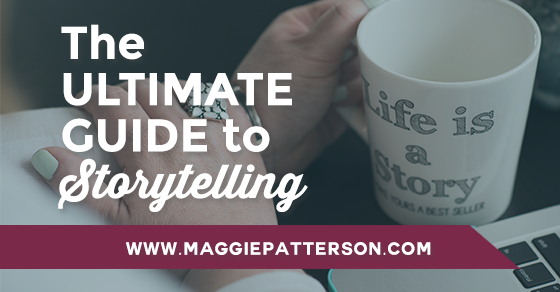
When was the last time you read a good book? You know, the kind that keeps you up half the night, even though you have a zillion things to do in the morning, because you MUST know how it’s going to end.
There’s nothing like a gripping page turner that you can’t put down. It leaves a lasting impression and sticks with you for weeks and months to come – but most of all, you can’t wait to share with your friends.
That’s the power of a great story at work.
So when it comes to sharing stories in your business, it can feel like a lot of pressure. The word insurmountable comes to mind, especially if you’re like me and you had a relatively “normal” upbringing and there’s no big dramatic turn of events. Or if you’re the kind of person who knows their mama wouldn’t appreciate you airing your family’s dirty laundry in public.
Not every story needs to have melodramatic twists and turns. Especially when it comes to the stories you share in your business.
The goal of sharing your stories is to create a link with your audience, no drama needed. As the saying goes, facts tell, stories sell.
At the heart of storytelling is making an emotional connection, and many times sharing something your audience can see themselves in is just as powerful as a rags to riches or overcoming the odds type of story.
Which is why I’ve put together the ultimate guide to storytelling to help you tell your personal story.
Understand What Your Audience Needs From You
If you’re going to share stories, you must be thoughtful about them. Otherwise you’re going to end up sharing a lot of things that don’t support your business or risk portraying yourself in a way that doesn’t jive with your community.
It’s not about taking on airs or being a big old fake, but you need to have a filter to run things through to make sure there’s a point to the story. Otherwise it’s just one big autobiographical storytelling jam session, which gets tired quickly.
The filter? Get to know what your audience is thinking, feeling and sensing. What do they need to hear? What are they looking for? Spending time on carefully defining this lets you frame how you communicate and what stories are worth telling.
A Little Personal Color Goes a Long Way
When you share personal stories, the audience filter comes in handy. You need to think about what’s a good fit for your audience and what may be completely over the top.
Personal stories are an ideal way for your tribe to learn more about you as a human and not just as an entrepreneur, coach or whatever it is you do. But do yourself a favor and be choosy about the stories you put out there.
In this iteration of my business, I’m willing to put myself way more out there than I EVER have and I make a point of sharing my own personal brand of my real-life anecdotes and straight talk. But that doesn’t mean it’s all about me and I let it all hang out.
The thing is I’m still a mom, and one day my kid will be able to read these words. I have a husband who works in a pretty conservative environment and I can guarantee there’s certain things he doesn’t want to see on the Internet. My friends likely wouldn’t appreciate me spilling the beans on some of our escapades or things that I’ve experienced alongside them (because while these things have shaped me in a profound way, they aren’t mine to share).
I know where my line is and I’m respectful of it. Because no one needs to know about that one time in Vegas. (Or maybe you do…but that’s a story for another day!)
[clickToTweet tweet=”Where’s your line when it comes to personal storytelling? New blog post.” quote=”Where’s your line when it comes to personal storytelling? New blog post.”]
Be Credible, But Don’t Oversell It
Part of storytelling in a business context is about stories that help you position your experience and how you’ve gotten to where you are today.
When I work with Story Distillery clients, we spend a lot of time working on packaging their experience in a way that’s credible but still accessible. The last thing you want to do is list ALL of the things you’ve ever done and how incredibly awesome you are.
For starters, that gets old quickly. Do you want to read an About page that requires you to scroll and scroll and scroll as someone recounts all the things? And then there’s the fact that if you didn’t lose your reader along the way, you may actually be intimidating them and they’re going to be scared to engage with you. (Sounds crazy, right? But people like to see themselves in people they work with or buy from.)
Think of your experience as needing a highlight reel. And on your About page or anywhere you talk about credibility, you share only the highlights, leaving the rest to be revealed over time.
You’re Not A Superstar
When you think of sharing stories in your business, it’s easy to think you’re the star. Because these stories are about you, right?
Not so fast! As you’re telling stories, you want to leave room to turn your clients and customers into the hero. What people really want to know from you is “how can they help me?” so showcasing your customers as the superstar lets you prove that you can deliver.
When you’re shaping these stories, focus on results. The personal relationship is important, but if you don’t deliver the goods, it’s not going to matter.
As a kid, I used to watch this TV makeover show called The New You with my mom, and I became pretty obsessed with the idea of the before and after. And I’m not alone. Transformation stories are incredibly powerful. That’s exactly why magazines and media are chalked full of them, and I’ve probably spent more hours of my life than I care to admit watching What Not to Wear and Style by Jury.
Think about what the before and after is for your clients. Start there and find ways to weave those stories into your marketing.
Stand for Something
Author, speaker and creator of the Fascination Advantage System, Sally Hogshead, has a quote that I love:
Different is better than better.
The point being you can work harder and do more, but if you’re not different, it’s hella hard to get a leg up. Which is why when you’re telling stories, you need to stand for something.
For some people, that idea can be scary, especially if you’re a people pleaser and the idea of someone not liking you is unthinkable.
If you want to truly be remarkable, it’s time to get over it.
To succeed, you’re going to need to embrace that you can’t work with everyone, you can’t serve everyone, and you’re actually doing yourself a disservice if everyone likes you.
The sooner you embrace that fact, the whole lot easier being in business and telling stories is going to be.
What does it mean to take a stand?
I’ll tell you what it doesn’t mean. You don’t need to stand on a table and rally a frenetic crowd of supporters to follow you into a battle you’re likely to lose.
For your business, it means you take ownership of key issues and have an opinion. This is what successful leaders do, and if you want to cut through the same old, same old, then it’s compulsory.
Find a way to state what you believe in a way that works for you. Take careful note of the “for you” part, as we’re all going to do this differently, and for it to work it must be aligned with how you actually are as a person.
If you need a hint, look at your Fascination Advantage report. My primary advantage is innovation and I lean on it a lot as I speak the language of ideas.
Otherwise you’re going to stay in obscurity and it’s hard to run a business when no one knows who you are.
[clickToTweet tweet=”Stop being a people pleaser and take a stand on something already.” quote=”Stop being a people pleaser and take a stand on something already.”]


